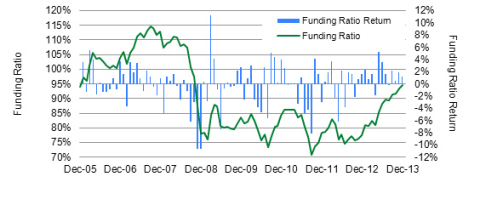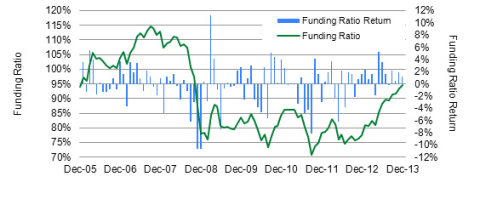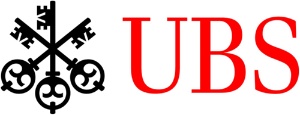CHICAGO--(BUSINESS WIRE)--During the fourth quarter of 2013, the UBS Global Asset Management US Pension Fund Fitness Tracker saw the funding ratio of the typical corporate US pension plan rise by about three percentage points to 95%. Overall, 2013 was a very strong year for corporate pension plans, as we estimate that the average funding ratio rose by about 17 percentage points.
Strong investment returns of 4.7% were the main contributor to the improvement in the funding ratio during the quarter. Liability values are estimated to have increased by 1.1%. These estimates are based on the average corporate plan’s reported asset allocation weightings from the UBS Global Asset Management Pension 500 Database and publicly available benchmark information.
The US equity market finished the year with a final surge upwards, as the S&P 500 Index recorded a 10.5% total return over the quarter. In October, the prospect of a US default had virtually no impact on the equity markets, which continued their rally once a deal was reached. The rest of the quarter was dominated by investors' bets on the timing of the US Federal Reserve (Fed) reduction of its quantitative easing (QE) program. In the US, the economic outlook remains positive, with the Chicago PMI level strongly above consensus, while employment data showed moderate, but stable growth. In Europe, the European Central Bank (ECB) responded to deflationary pressures by cutting rates by 25 basis points (bps) to 0.25%. In US dollar (USD) terms, the Euro Stoxx Index was up 9.6% over the quarter. In the last three months of the year, China's economic data met expectations, and the MSCI Emerging Markets Index was up 1.9% in USD terms.
After a volatile quarter, the yield on 10-year US Treasury bonds increased by 42 bps, ending at 3.03%. The yield on 30-year US Treasury bonds increased 29 bps, ending at 3.97%. High-quality corporate bond credit spreads, as measured by the Barclays Capital Long Credit A+ option-adjusted spread, ended the quarter 27 bps tighter. As a result, pension discount rates (which are based on the yield of high-quality investment grade corporate bonds) were flat. The passage of time caused liabilities for a typical pension plan to increase by about one percentage point over the quarter. Together, these effects caused liabilities to increase 1.1% for the quarter. (Please see disclosures for assumptions and methodology.)
Disclosures and methodology
Funding ratio
Funding ratios measure a pension fund’s ability to meet future payout obligations to plan participants. The main factors impacting the funding ratio of a typical US defined benefit plan are equity market returns, which grow (or shrink) the asset pool from which plan participants’ benefits are paid, and liability returns, which move inversely to interest rates.
Liability indices: Methodology
Pension Protection Act (PPA) liability returns are approximated by the Barclays Capital US Long Credit A-AAA Index. This index broadly reflects the duration and credit characteristics of the PPA discount curve that is used to discount expected pension benefit payments for US defined benefit pension plans.
Asset index: Methodology
UBS Global Asset Management approximates the return for the ”typical” US defined benefit plan using the reported asset allocation of the UBS Global Asset Management Pension 500 Database. The series is constructed using the aggregate asset allocation weightings and publicly available benchmark information, with geometrically linked monthly total returns.
Pension Fund Fitness Tracker: Methodology
The US Pension Fund Fitness Tracker is the ratio of the asset index over the liability index. Assuming all other factors remain constant, it combines asset and liability returns and measures the impact of a “typical” investment strategy on the funding ratio of a model defined benefit plan in the US due to interest rollup, change in interest rates and typical asset performance, but excludes unique plan factors, such as service cost and benefit payments.
The UBS Global Asset Management Pension 500 Database
The UBS Global Asset Management Pension 500 Database is a proprietary database that is based on the analysis of 500 public companies sponsoring large defined benefit plans. The information was extracted from the companies’ 10-K statements. The study may include figures for companies’ nonqualified and foreign plans, both of which are not subject to ERISA.
The aggregate asset allocation is based on an equally weighted average of the 500 companies included in the database. The aggregate asset allocation includes equities, fixed income, hedge funds, private equity, real estate and cash.
About UBS
UBS draws on its 150-year heritage to serve private, institutional and corporate clients worldwide, as well as retail clients in Switzerland. Its business strategy is centered on its pre-eminent global wealth management businesses and its leading universal bank in Switzerland. Together with a client-focused Investment Bank and a strong, well-diversified Global Asset Management business, UBS will expand its premier wealth management franchise and drive further growth across the Group.
UBS is present in all major financial centers worldwide. It has offices in more than 50 countries, with about 35% of its employees working in the Americas, 36% in Switzerland, 17% in the rest of Europe, the Middle East and Africa and 12% in Asia Pacific. UBS employs about 61,000 people around the world. Its shares are listed on the SIX Swiss Exchange and the New York Stock Exchange (NYSE).
About UBS Global Asset Management
Global Asset Management is a large-scale asset manager with businesses diversified across regions, capabilities and distribution channels. It offers investment capabilities and styles across all major traditional and alternative asset classes including equities, fixed income, currencies, hedge funds, real estate, infrastructure and private equity that can also be combined into multi-asset strategies. The fund services unit provides professional services including fund set-up, accounting and reporting for both traditional investment funds and alternative funds.




